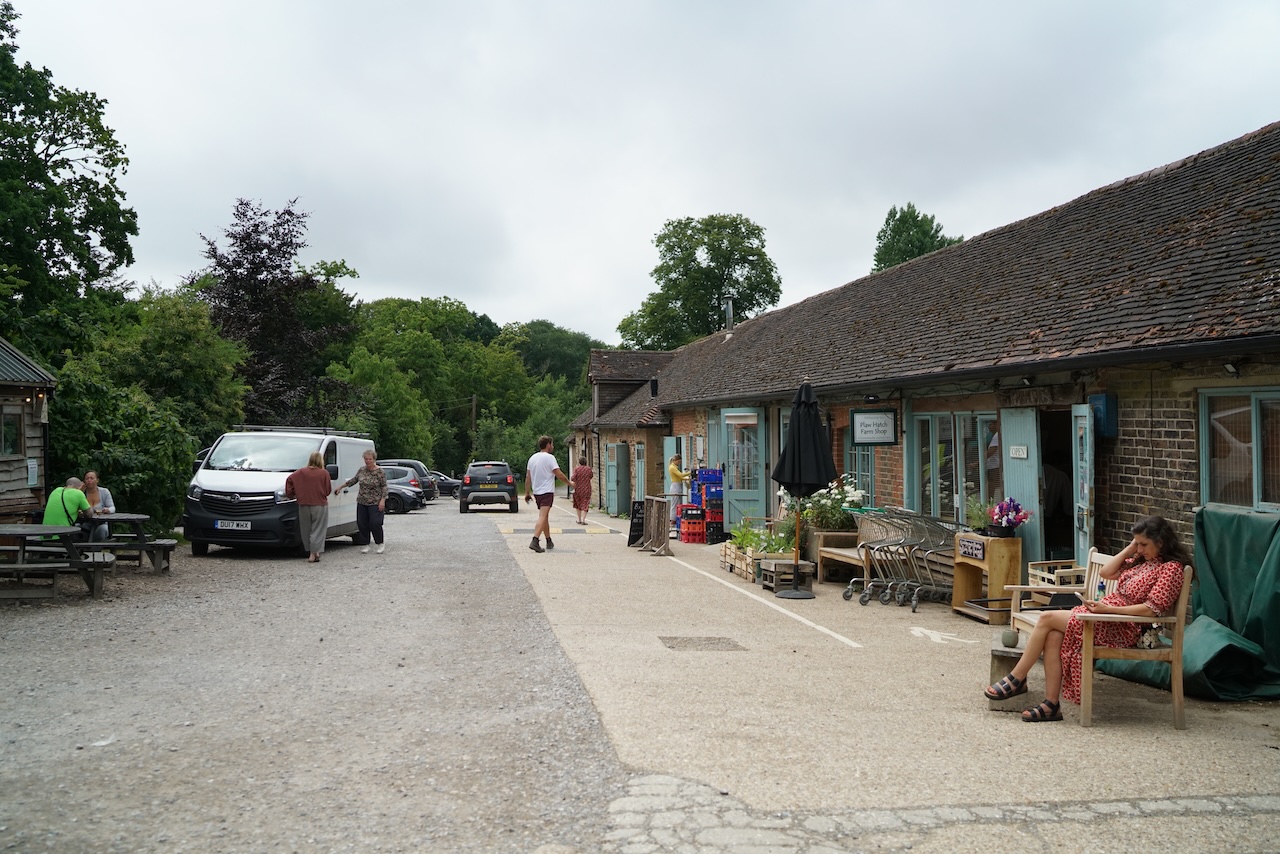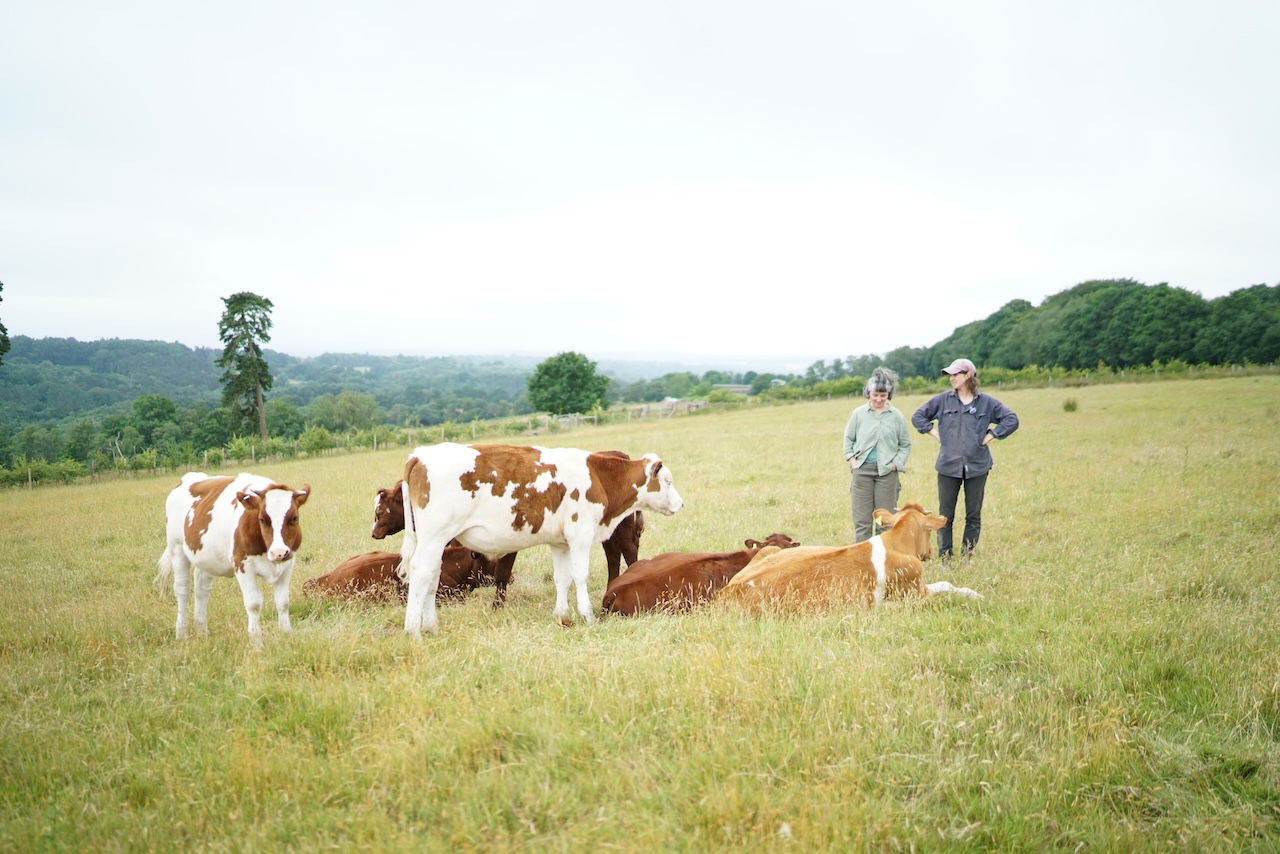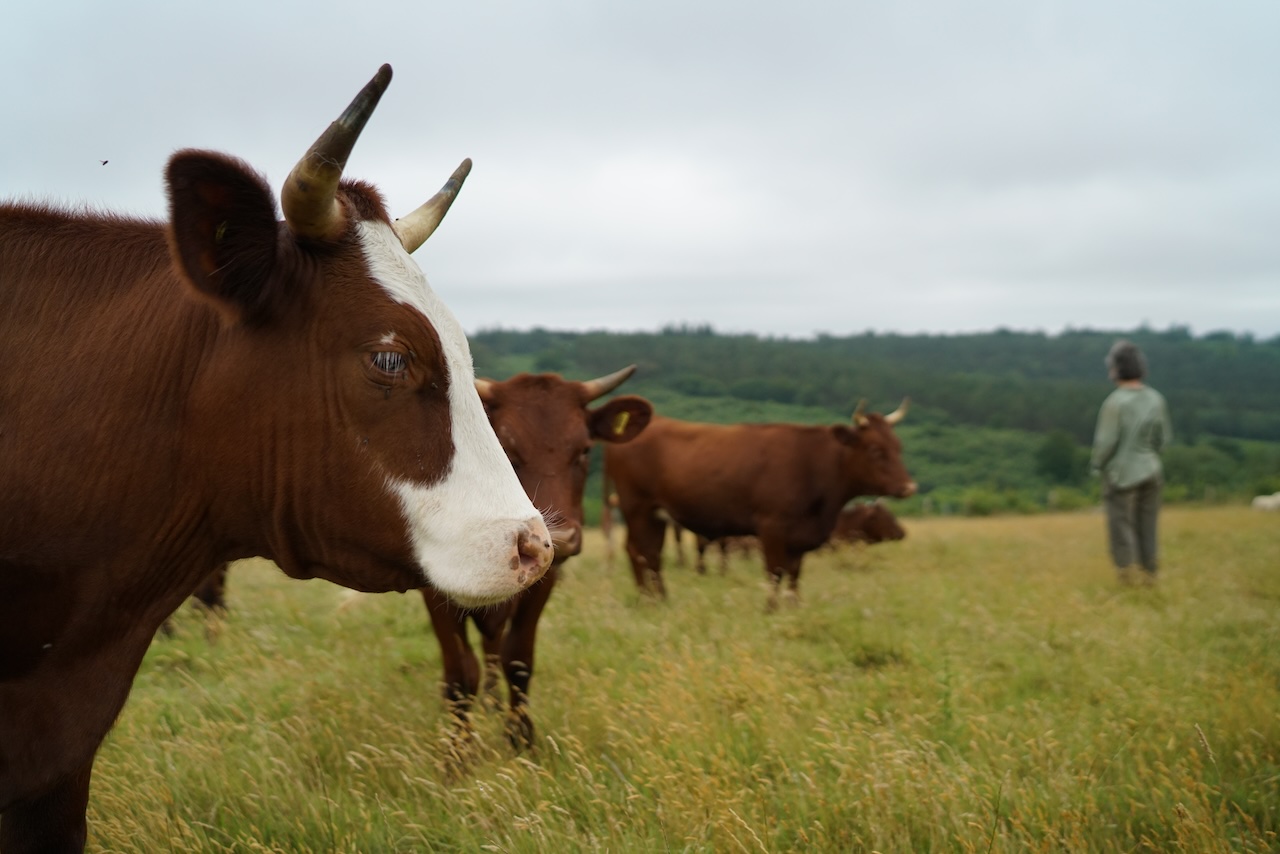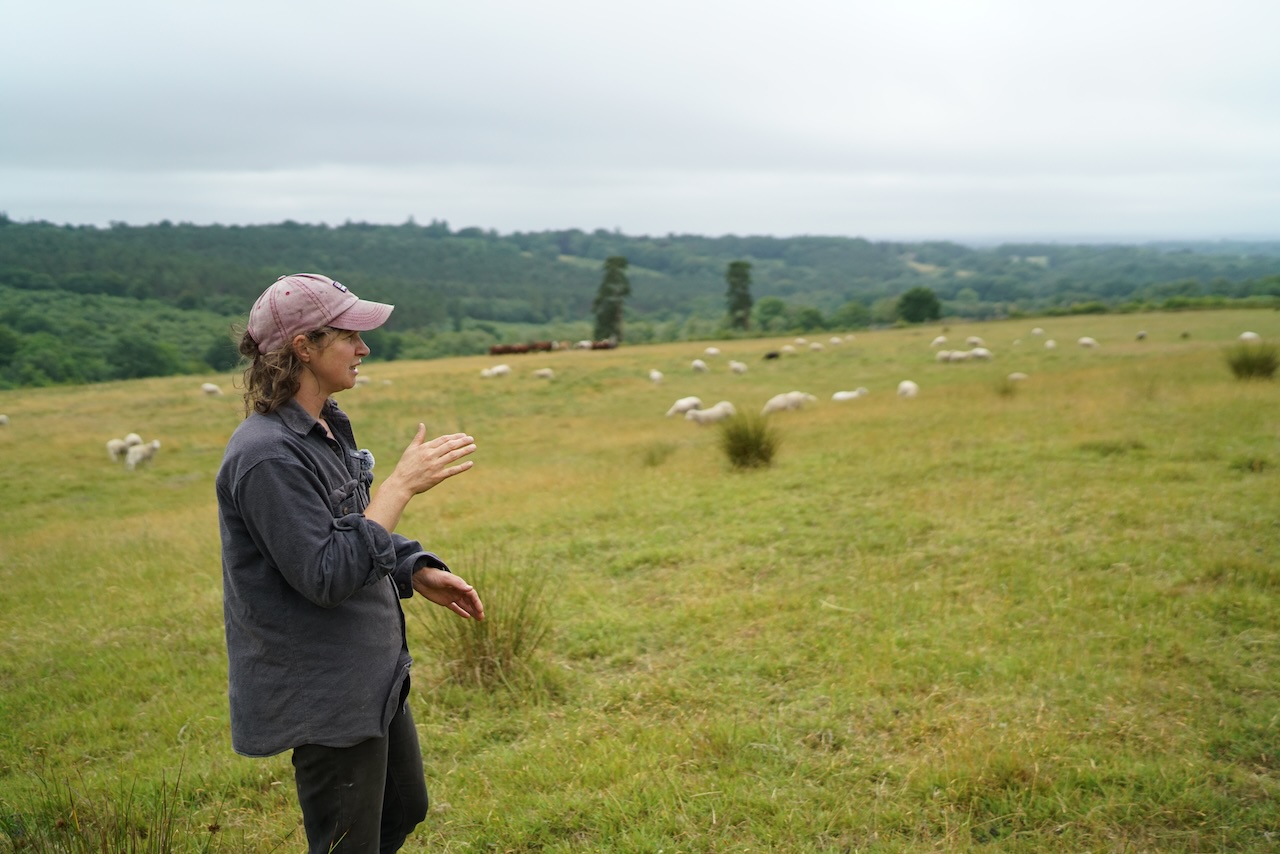Plaw Hatch Farm, a 200-acre biodynamic co-operative on the edge of the Ashdown Forest in East Sussex, is no ordinary farm. Owned by more than 700 shareholders and run by a community of growers and livestock keepers, it is home to a thriving dairy, market garden, farm shop and butchery — as well as a flock of Romneys, Lleyns and crosses cared for by shepherd Gala Bailey-Barker. In the first of a twelve-part series supported by the Lund Trust and the High Weald National Landscape, Indie Farmer explores how this unique community enterprise approaches sheep farming, wool and sheepskin production, cooperative decision-making and regenerative grazing.
On a warm, breezy morning at Plaw Hatch Farm, Gala walks ahead of me towards a small flock of tegs (young sheep between 12-24 months old) grazing contentedly among thistles and dock leaves on the headland of a potato field. A black Romney ram eyes us warily. “That one’s a keeper,” she said, pointing to a grey-fleeced tup she bred herself. “It’ll be interesting to see if he throws any black lambs.”
Plaw Hatch, on the edge of the Ashdown Forest in Sussex, is a 200-acre biodynamic farm with its own shop, dairy, butchery and market garden. The farm is run as a co-operative, owned by a community of 700 shareholders who each hold a £100 stake. There’s no private owner and no dividends — any profit is reinvested into the farm.
“It’s a very different feeling to working for someone with stacks of money,” Gala reflects. “Here, everything we make goes back into the farm. It doesn’t mean you can’t burn out — you definitely could — but you know it’s not funding somebody else’s lifestyle.”
The flock
Gala manages around 60 breeding ewes, mostly Romneys, along with some Lleyns and Romney cross Lleyns, a few black Romneys and the odd Shetland-Icelandic cross. The flock is closed, meaning all replacements are bred on the farm, and variety in the fleeces is intentional.
She talks me through her ram choices over the years — Jacob crosses that didn’t work and the challenges of finding unrelated black Romneys in the UK.
Wool here is not an afterthought. In fact, Gala says some years the sheepskins bring in more than the meat. She takes the lambs to the abattoir herself, waiting to collect the skins and then salts them immediately back at the farm, before sending them to the Welsh Organic Tannery. “They’re organically tanned with mimosa (a method of tanning using tannins extracted from mimosa bark, resulting in a natural, light-colored leather with flexibility and softness). They also use the wool from shearing the ewes, which is spun into yarn to make black, white and beautiful grey blankets from mixing the fleeces.”
The success is partly down to having a shop on site. “That’s the barrier for a lot of people — processing is expensive, and you need somewhere busy to sell them. We’re lucky to have that footfall.”

A shared farm, shared responsibility
Around 40 people are employed at Plaw Hatch Farm, working across the dairy, market garden, farm shop, and butchery. Four core farmers — Gala, Lou, Maya and Daniel — form the management team, each taking responsibility for one or two enterprises, including their respective budgets. It’s a flat, cooperative structure without a traditional boss — decisions are made collectively, and mistakes are owned collectively too.
“It requires a lot of taking responsibility,” explains Gala. “There’s no boss to blame if something goes wrong. You have to own your decisions.”
The shared setup, along with on-site housing for full-time staff, makes living and working on the farm viable — particularly important in an area where property prices are high. “It’s the only reason it works,” says Gala. “A farm salary alone wouldn’t get you anywhere near being able to live in Sussex.”
Unlike a family farm, there’s no asset to inherit, no legacy to pass on. “If I left tomorrow, that’s it — there’s no financial relationship with the farm beyond the monthly salary I’m paid,” Gala reflects. “We’re employees, not owners.”
But while there’s no equity, there is a strong sense of shared purpose and community. “It’s important we have a job that allows us time off and the ability to rest,” she continues. “That might not sound radical, but in farming it is. It’s only in the last five years that we’ve managed to make two days off a week standard, and ensure people can take holidays too.”
Of course, the boundaries can blur. “I was meant to be off on Sunday, but I ended up fencing — when something happens, you all swing back into action,” Gala smiles. “But we try our best to protect people’s time.”

Female Farmers, working smarter — and the real cost of labour
“There’s still a lot of farming relationships where the mother is doing everything — looking after the children, feeding everyone, doing all the washing,” Gala reflects. “And yet today, most families need two incomes. If someone’s female partner comes to work here, they’ll need a job — but they’re also often still expected to do all the domestic work too.”
At Plaw Hatch, the team is majority female — and that reality brings a different awareness to how labour is valued, both on and off the farm. “Even if you’re single and don’t have kids, you still have to do everything — cook for yourself, keep your life running. We’re all on 48-hour contracts, but it’s a struggle to fit the work into that time.”
It’s led to a culture of working smarter, not just harder. “I try not to make my life more difficult than it needs to be,” she says. “As a team, we’re slowly making improvements. We’re getting a cluster flush system and adding two more milking points — going from four to six. At the moment, it takes us a ridiculous amount of time to milk 22 cows. Dan Burdett’s milking 200 in probably the same time it takes us.”
The drive for efficiency isn’t just about convenience — it’s about sustainability, in the truest sense of the word. “There are so many reasons to make the milking faster. Labour is a big one. When you treat labour as cheap, it becomes dangerous — because then you don’t invest in the systems or infrastructure that make things better.”
The economics are only getting tougher. “National Insurance contributions have gone up, so it’s got a lot more expensive for the business to employ people. But there’s a limit to how much we can pass that cost on through the shop.”
Even staff, with a discount, are starting to feel the pinch. “I buy the food here. And I love eating really good food — it’s probably a third of the reason I work here. But it’s getting to the point where I might not be able to afford it.”
It’s a complex and evolving puzzle — figuring out what a fair price point is, what the true cost of production should be, and how to balance values with viability.
Mob grazing and mixed stock
The dairy cows, all horned, graze on 12 hour moves, fully back-fenced, to build resilience into the pasture during increasingly dry summers. “If we were still strip grazing tightly like we used to, we’d have no grass left in a drought like this.”
Sheep and cattle graze in rotation, the sheep often deployed to “weed the headlands” around the potato crop. Kiwi kit troughs and portable fencing make the moves easier, though Gala dreams of more semi-permanent infrastructure.
Challenges and opportunities
We talked about deer pressure from the neighbouring Ashdown Forest — “A fallow deer eats 50% more than a sheep” — and the frustration of TB movement restrictions, which prevent cattle from being grazed on distant blocks of land.
Small abattoir closures are another concern. Plaw Hatch uses Downland Traditional Meats for beef and sheep, but lead times for pigs are now so long “you have to book them in before they’re born.” One of the reasons they no longer rear pigs on the farm. Gala believes abattoirs should be publicly funded infrastructure.
Then there’s the public. The shop draws an affluent local customer base, but the farmyard also attracts less respectful visitors. “Someone was holding their toddler over the wall into the collecting yard the other week — right in front of a cow with horns. People have no idea how dangerous that can be.”

Why stay?
So why, after 13 years, is Gala still at Plaw Hatch? She smiles.
“I was always going to work somewhere where I had a lot of autonomy. I also love the variety. I can be moving sheep one minute, planting hedges the next, then doing an RPA application in the afternoon. We’re not trying to get bigger — we’re trying to do what we’ve got better. And that’s endlessly fascinating.”
As we walk back towards the shop to grab some lunch, past the dairy and the popular coffee hut, the farm is buzzing with activity. A constant stream of customers come and go from the shop, which is full of delicious fresh produce.
It’s a vivid snapshot of a farm where meat, milk, veg, wool, community and ecology are all deeply intertwined — and where farming is as much about relationships, trust and shared responsibility as it is about livestock and land.
More Information
To help bring the series to life, I also filmed and edited short video episodes from each of my farm visits, which you can watch over on my Indie Farmer YouTube channel. The first one features Gala and it’s split into three parts, all linked below.
Indie Farmer Stories – Plaw Hatch Farm – Episode 1 Part 1
Indie Farmer Stories – Plaw Hatch Farm – Episode 1 Part 2
Indie Farmer Stories – Plaw Hatch Farm – Episode 1 Part 3



